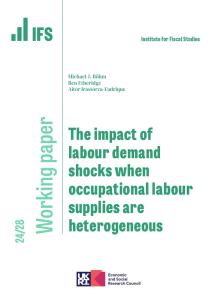The coronavirus pandemic was an unprecedented shock to the labour market. Lockdown measures and general uncertainty led to a collapse in hiring across the economy, leading to sizeable and unequal impacts on people’s ability to work and to progress their careers. Now, two years on from the start of the pandemic, all restrictions have been lifted, GDP has returned to pre-pandemic levels, and vacancy postings have stabilised well above pre-pandemic levels. In this briefing note, we reflect on the current state of the labour market and ask whether the composition of jobs demanded looks different in ways which could affect the careers of workers.
We combine data on vacancy postings from Adzuna, an online job aggregator, with information on the characteristics of workers from the Labour Force Survey.[1] Following substantial changes in the occupational composition of jobs advertised during the pandemic, the overall mix of occupations in vacancy postings is rapidly returning to that seen in 2019. In fact, quite remarkably, changes in the composition of vacancies since the pandemic began have been no bigger than what we would normally expect over a two-year period. But some important differences in the vacancy mix remain: in particular, there has been a shift towards lower-skilled and lower-paid occupations, including drivers and warehouse workers.
It is still too early to tell whether there is a ‘new normal’ in the labour market, with more abundant opportunities for workers and a permanent shift in demand towards lower-skilled and lower-paid occupations. The level and composition of vacancies today are also likely to reflect the currently high level of job turnover, as workers who take new jobs leave vacancies in their wake, and changes in the composition of the supply of suitable workers due to outmigration and job exits due to factors such as early retirement. It remains to be seen to what extent these shifts persist beyond the aftermath of the pandemic and Brexit.
Key findings
- Vacancy postings have exceeded pre-pandemic levels for nearly a year. The number of vacancies has been stable, and at least 20% above pre-pandemic levels, since Autumn 2021. As a result, almost all unemployed workers face more job vacancies that match their skills than they would have done before the pandemic.
- After a massive collapse in hiring and a large skew in vacancies towards sectors such as healthcare during the pandemic, the overall mix of vacancies advertised today is remarkably similar to before the pandemic. That is, some occupations have become more represented, and some less, when compared with 2019 – but the overall amount of change (as measured by a standard dissimilarity index) is no greater than it was during the more ‘normal’ period between 2017 and 2019.
- However, if we focus on those changes that have taken place, we can see a systematic pattern: a shift towards vacancies in lower-skilled and lower-paid occupations. For example, vacancies for warehouse workers in the five months to February 2022 were more than double their pre-pandemic level, and vacancies for drivers were 80% higher. Higher vacancies in some occupations do not appear to have pushed up wages – there is no correlation between the change in vacancies and the change in wages across occupations since 2019.
- The fact that vacancies have risen most in lower-skilled occupations means that job market opportunities have improved most for low-educated workers. 70% of unemployed workers without a degree had opportunities that were more than 40% higher than they would have had before the pandemic, compared with just 44% of those with a degree. It also means that, while vacancies are high across the board, many of the new opportunities facing jobseekers are in relatively low-paying jobs.
- It remains to be seen whether these changes in the level and composition of vacancies reflect a permanent change in the labour market, as opposed to a transitory adjustment to the pandemic and Brexit.
[1] We use microdata from UKDS: https://discover.ukdataservice.ac.uk/series/?sn=2000026.














